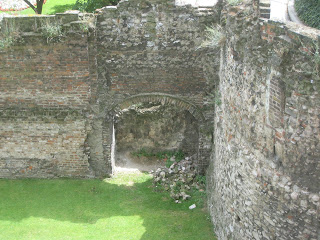Museum of London opened in 1976 as an amalgamation of the Guildhall Museum (est. 1820s) and the London Museum (est. 1912). It is funded by the City of London Corporation and the Greater London Authority, with a budget of about £25-30 million a year - admission is completely free, which is wonderful; however, a donation of £3 is suggested. Jon Cotton, the Senior Curator in Prehistory, was gracious enough to give us a presentation on the museum and on the Prehistory exhibit, London Before London: c. 450,000 B.C. to c. A.D. 50. (and the exhibit's ancestors). Of course, history museums often demonstrate evolution, but I've never quite seen it so clearly than at MoL. In fact, the exhibits not only informed me of the history of London, but the Prehistory exhibit in particular lent detailed insight into human evolution. Mr. Cotton asked us to evaluate the exhibit and see if we thought it satisfied the four main "take home messages" for its visitors, which are:
--The massive changes wrought on the landscape by natural and human agencies
--The centrality of the Thames to the LBL story
--The dynamism and adaptability of human communities in the region
--The prehistoric legacy after A.D. 50
The answer is yes, on all accounts (although I do think the sheet he gave us helps comprehension of the exhibit's goals). The LBL exhibit is full of findings from archaeological digs (with some replicas here and there). The progression and evolution of ancient Londoners through history is clearly demonstrated in the displays of human tools, which change and evolve as the centuries pass.

Although London's prehistory was initi
 ally emphasized, I found two other exhibits to be particularly fascinating - London's Burning: the Great Fire of London 1666, and the simple view of the remains of an ancient wall. The wall, according to the exhibit, has been repaired several times, and the remains are later walls built on the foundations of the ancient Roman wall. There is also a 13th century tower. The corroded, crumbling structure was in sharp contrast to the lush gardens to its right, with a busy London street to its left - it seemed so out of place in spite of its hoary claim to the spot.
ally emphasized, I found two other exhibits to be particularly fascinating - London's Burning: the Great Fire of London 1666, and the simple view of the remains of an ancient wall. The wall, according to the exhibit, has been repaired several times, and the remains are later walls built on the foundations of the ancient Roman wall. There is also a 13th century tower. The corroded, crumbling structure was in sharp contrast to the lush gardens to its right, with a busy London street to its left - it seemed so out of place in spite of its hoary claim to the spot.
The primary lesson I have learned, which has come up a few times already in less than a week, is that London as a city (currently a huge urban space) is ever-evolving. Whether by evolution, conquest, tragedy, or war, London has never been the same architectural place for very long, but it is filled with a rich history and a hopefully bright future.
For more information on the Museum of London and any of their current or upcoming exhibits, check out their website.
No comments:
Post a Comment